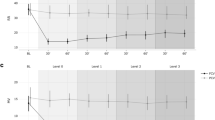Abstract
Background: We examined the questions of whether resuscitated (compensated) acute hemorrhage enhances the negative effects of carbopneumoperitoneum on hemodynamic and respiratory parameters and whether pneumoperitoneum with helium has any advantages under these circumstances. Our investigation focused on the influence of acute hemorrhage with different gases on the cardiovascular and respiratory system as well as on hepatic and renal blood flow in a porcine model.
Methods: Cardiac and hemodynamic function were monitored via implantation of catheters in pulmonary artery, femoral vein, and artery. Renal and hepatic blood flow were recorded using a transonic volume flow meter placed at the renal and hepatic artery and portal vein. Twelve animals were randomly assigned to one insufflation gas (carbon dioxide [CO2] or helium [He]). Following baseline recordings, acute hemorrhage (20 ml/kg) was induced by continuous bleeding over 30 min. Animals then received a colloidal solution (20 ml/kg 6% hydroxyethylstarch solution) over 30 min. Pneumoperitoneum of 12 mmHg was established, and all parameters were measured after 30 min of adaptation. The major endpoints of the study were cardiac output (CO), arterial pressure (MAP), systemic vascular resistance (SVR), and central venous pressure (CVP), as well as blood flow in hepatic and renal artery and portal vein.
Results: While CO and hemodynamic parameter as well as hepatic and renal blood flow were markedly reduced after hemorrhage, they returned nearly to their previous levels after resuscitation. Pneumoperitoneum with 12 mmHg did not further depress the cardiovascular system or reduce hepatic and renal blood flow. Pneumoperitoneum did not alter hepatic or renal blood flow. Pneumoperitoneum with helium did not substantially change the reaction of the cardiovascular system after resuscitated hemorrhage.
Conclusions: If hemorrhage is compensated by proper resuscitation and hypovolemia is avoided, laparoscopic surgery with pneumoperitoneum of 12 mmHg appears to be not harmful. Using helium as the insufflating gas had no clear advantage over the carbon dioxide model.
Similar content being viewed by others
Author information
Authors and Affiliations
Additional information
Received: 30 July 1997/Accepted: 24 October 1997
Rights and permissions
About this article
Cite this article
Gründel, K., Böhm, B., Bauwens, K. et al. Influence of acute hemorrhage and pneumoperitoneum on hemodynamic and respiratory parameters. Surg Endosc 12, 809–812 (1998). https://doi.org/10.1007/s004649900718
Issue Date:
DOI: https://doi.org/10.1007/s004649900718




